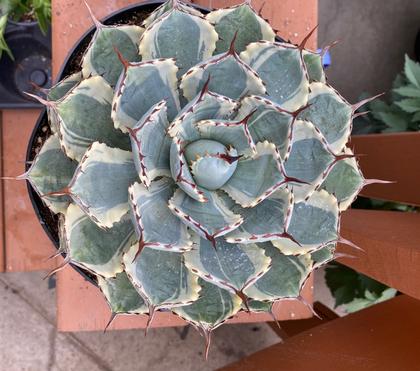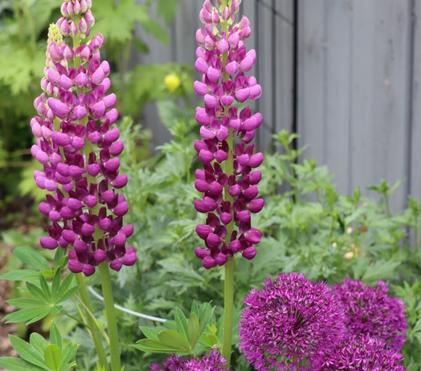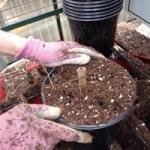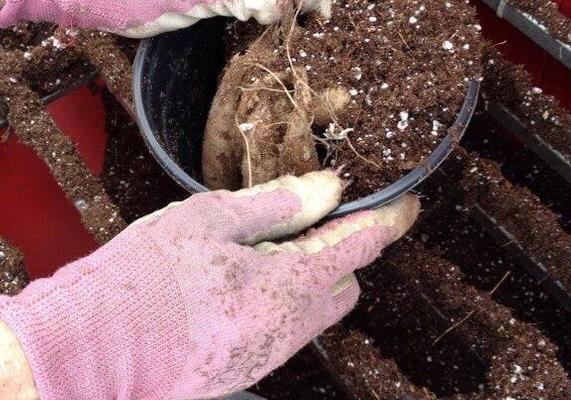Bringing Dahlia Tubers Back to Life
Dahlias, in their amazing array of colours and styles, bring sparkle and drama to a garden space. Dahlias are the flowers that your neighbours will stop and ask about. The dahlia family offers a multitude of choices in colour, height, and flower type to compliment your garden the best.
To get dahlias to bloom at the right time, their tubers need a jump start at life early on.
When to Plant a Dahlia Tuber
Timing is important for growing dahlia tubers. If they are planted too late, blooming will be delayed and if they are planted too early there can be other problems related to keeping them growing healthy indoors.
Planting dahlias too early indoors can cause issues with stretching because:
- The amount of light available may be too low – dahlias will stretch toward the light as photosynthesis is compromised.
- The temperatures are too hot – When the ambient temperature is too warm for dahlias, it increases their metabolic needs and causes them grow too fast.
Despite our most valiant efforts, most home environments tend to be lower in light and have warmer temperatures than really is optimal. Watch your dahlia as it grows and starts to stretch. You may need to move it to a space that is cooler and has more light. You may also use supplemental lighting. See our blog referenced below where we discuss grow lighting.
Related: How We Use Supplemental LED Grow Lights
The Best Time to Plant Dahlia Tubers
Plan on planting dahlia tubers on or around St. Patrick’s Day. Why St. Patrick’s Day? We all know that St. Patrick’s Day is a magical day, but on the plant side of things, there is nothing special about St .Patrick’s Day. It’s just a day that most people remember, and green is the theme of that day.
Mid-March to the beginning of April is the best time for growing dahlia tubers in the Edmonton area – this gives the plant time to get started and to develop enough growth so that it can be pinched back to bulk up and get ready for blooming.
At our greenhouse we grow dahlias in a warm area (20ºC) to help them burst from dormancy. We keep them there until they grow to 4 or 5 inches tall and then move them out to our cooler perennial cold frame that hovers around 65 Fahrenheit (17º or 18º C) to prevent the stretching.
What Does a Healthy Dahlia Tuber Look Like?
Dahlia tubers hold nutrition and energy for the emerging plant. They are interesting to look at – they look like a cross between a potato and a cassava root. The health of the dahlia tuber will directly affect the health of the dahlia plant.
Characteristics of a Dahlia Tuber:
- Appearance: Strong dahlia roots always have a central stem with multiple root tubers attached. You could have a dahlia root with as few as 2 tubers or you could have a cluster with as many as 6 or 7.
- Tuber shape: Dahlia root tubers can be round or oblong in shape. Older tubers look wrinkled, and young tubers are smooth.
- Tuber skin colour: The outer skin can range to anywhere from a light beige to deep brown colour – the outside skin is good for the roots, so keep that skin on, do not peel it off.
- Tuber texture: Tubers should feel dense like a potato. Firm tubers are perfect for planting. If they are just a little soft, that’s probably fine, so give it a go. But if they are quite soft and squishy, and you have slime oozing out when you squeeze it, it has rotted & it’s done – you can just compost that tuber right now.
How to Plant Dahlia Tubers
Let’s look at how to bring dahlia tubers back to life with the 2 different methods.
Planting Loose Dahlia Tubers:
- If you have over wintered the dahlia tubers in peat moss or bought new tubers, first assess the tuber health with the above criteria.
- Plant the tuber – Place the tuber in a good quality potting soil with the top of the tubers placed about 1 inch below the soil surface and the stem sticking upward. Be careful to get soil in and around all of the tubers – if there is no soil surrounding the tubers, it keeps the tuber from getting water. Also be mindful to not pack the soil tightly. If the soil is packed down, it is difficult for the new shoots to break though the soil.
- Water it – Give the tuber 2–4 cups of water, keep it warm – at about 20°C – and in the light. You should see growth in 2 or 3 weeks.
- Avoid giving additional water (it will be hard, but trust us) unless the soil is very dry because dahlias get their nutrients initially from the bulb as we mentioned above.
- Too much water makes the roots mushy and rot.
Planting Dahlia Tubers from a Pot:
- If you kept your Dahlia in a pot through the winter, bring the container into the light and warmth & give it just a little water, like 2-4 cups.
- You should see some growth in about 2-3 weeks; avoid giving it any more water unless it is very dry.
- Dahlias don’t initially need much water because the nutrients come from the tubers. Too much water will cause the tubers to rot.
Caring for a Dahlia After it has Sprouted
Probably the most difficult time in this whole process is waiting for the dahlia to sprout. Just be patient and hold back the urge to give it more water. Once they get going, they will grow vigorously. They will need some special care and pinching to get them to a place where they will bloom well.
Initial Growth
Once you see green growth above the soil, let those sprouts grow in the warmth until they get to be 3”-6” tall. It won’t take long for them to grow to this height. When they get that tall, grow them in a cooler place. Optimal temperatures are 16-18°C. This will keep them from growing too fast and producing stems that are stretched and weak so they can’t support their heavy blossoms. Continue to water sparingly, they don’t need a lot of water yet.
Pinching Dahlias
Pinching is important for dahlias to grow well. Once dahlias have grown from 8-12” tall, they may be ready for a pinch. Some dahlias grow compact and others have wide and tall growth habit. Pinch when you can easily visualize the nodes. A node is where you see leaves growing from a stem. With dahlias, you will see 2 leaves growing from the opposite side of the stem.
It’s also important that you can comfortably get your fingers into the node to pinch off the stem. If the nodes are too small and tight, you may end up damaging more of the plant than you had anticipated.
Advantages to Pinching Dahlias:
- Promotes branching
- Strengthens the branches
- Develops stocky plant growth and good plant form
- Encourages multiple flowering
- Discourages stretching
Method for Pinching Dahlias
Dahlias have a mixed bag of growth habits. Compact or patio dahlias stay quite short (16”), they only need 1 pinch. Dahlias shorter than 16” need no pinching at all. But many dahlias grow from 28”-44” tall. These taller dahlias, like dinnerplate, fringed, bishop, and cactus dahlias need 2 pinches. Be sure to double check the tags on the tubers to know how tall your dahlia is expected to become.
First Pinch for Dahlias
- Starting at the very base of the main stem where it emerges from the soil, start counting nodes upward.
- Dahlia leaves grow in sets of 2, they develop on opposite sides of the stem from each other. That is called a node.
- Count upwards on the stem to the 3rd node.
- Pinch the growth coming from the center of that leaf set. You may use your fingers or clip it with scissors.
- New growth will develop on the lower nodes and the pinched node, making the plant fuller.
- After the 1st pinch, begin fertilizing weekly with and evenly balanced fertilizer like 20-20-20, or 15-30-15.
Related: See our blog called Unwinding the Fertilizer Numbers for more chat on fertilizer.
Second Pinch for Dahlias
- If the variety is a tall one with a height of 28” or taller, we recommend a 2nd pinch.
- Pinch back the new growth coming from the nodes.
- For example, start counting up from the soil again. Stop at the first node and see where the new branching is coming from that node. There should be 2 branches growing from that node, one branch by each leaf. Sometimes only one new branch grows, but that’s unusual.
- Now, count outward to 2 nodes on the new branch and pinch back the growth just like you did with the first pinch.
- There should be a second branch from that first node, now pinch that one back too.
- Continue your way up the stem and pinch back all of the new growth to 2 nodes.
Caring for Dahlias Through the Summer
As Dahlias grow through the summer, here are some tips for optimal growth:
Sun Exposure – Dahlias need a minimum of 6-8 hours of sunshine per day. This can be best achieved in an east, south, or western exposure. Watch for things that may limit sun exposure such as fences, houses, out buildings, or trees.
Avoid Wind – Dahlias have large leaves, and they act like sails on a sailboat when the wind blows. The wind will cause significant damage, be sure to place them in a sheltered location away from constant wind.
Support Structures – The tall dahlia varieties often need support structures. Tomato cages, both large and small; depending on the dahlia’s specs, work very well. It’s a good idea to get those cages in place while after the second pinch, while they are small. Weave the branches through as they continue to grow.
Water – Assess them daily for water needs. This shouldn’t be a long drawn out process; just a quick look should do it. The leaves should have a deep green colour and good turgor; strongly holding themselves up. The leaves shouldn’t be looking like laundry flapping on a clothesline. As dahlias grow larger, so does their need for water. They will wilt, or flag, when they need water. Water them deeply and thoroughly. The frequency and amount of water depends on a number of things like sun exposure, weather, and if they are growing in the ground or size of the pot.
Fertilize – make it a point to fertilize dahlias weekly. Dahlias are actively growing and blossoming plants, so they have a high fertilizer requirement. Use a balanced fertilizer that will support growth and flowering. All fertilizers have 3 numbers written on the packaging. The first number is for Nitrogen, the second is for Phosphorous, and the 3rd number is for Potassium. Recommended fertilizer formulas for dahlias are 20-20-20 or 15-30-15.
Deadhead – If we let dahlia flowers stay on the plant after flowering, they will produce seeds. To have continually flowering dahlias, the dried, spent flowers must be taken off. Remove deformed buds, too, because they take energy from the plant that can be used for the best blossoms. How? Just trace the flower stem back to the branch and cut if off with a clean pair of scissors or hand garden sheers. Clean tools mean healthy plants -dirty tools can spread disease. Keep your cutting tools clean by washing them or wiping them with soapy water.
Encourage Growth – Healthy growth means more flowers. Cut back deformed or old branches as needed to keep the dahlia plant in the best condition to continue blooming.
Related: Garden Maintenance: Why Deadhead?
In Conclusion
Dahlias are certainly worth the effort of growing. They add amazing colour, height, and texture to gardens and containers. They also make wonderful cut flowers. Wondering how to keep dahlia tubers over the winter?
Read Next: How To Easily Overwinter Dahlia Tubers Indoors (Canada)




